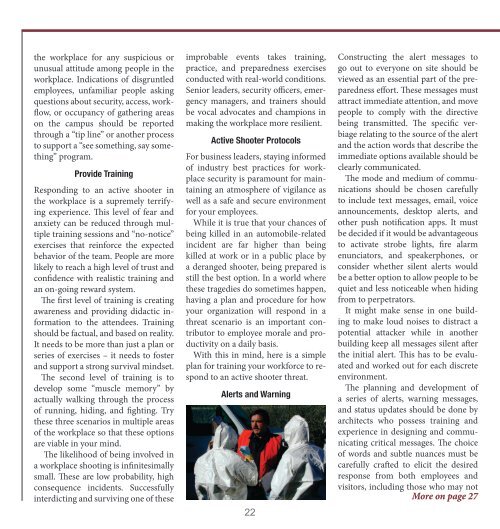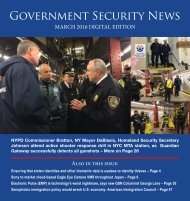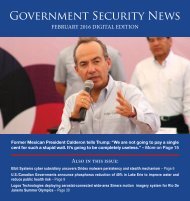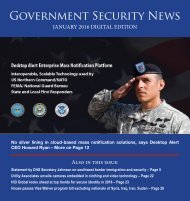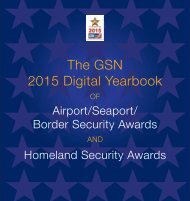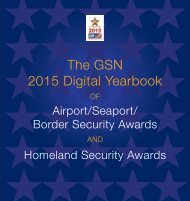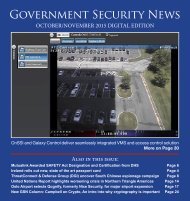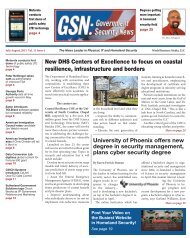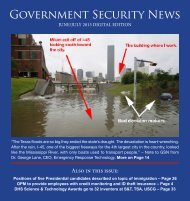GSN March 2016 Digital Edition
You also want an ePaper? Increase the reach of your titles
YUMPU automatically turns print PDFs into web optimized ePapers that Google loves.
the workplace for any suspicious or<br />
unusual attitude among people in the<br />
workplace. Indications of disgruntled<br />
employees, unfamiliar people asking<br />
questions about security, access, workflow,<br />
or occupancy of gathering areas<br />
on the campus should be reported<br />
through a “tip line” or another process<br />
to support a “see something, say something”<br />
program.<br />
Provide Training<br />
Responding to an active shooter in<br />
the workplace is a supremely terrifying<br />
experience. This level of fear and<br />
anxiety can be reduced through multiple<br />
training sessions and “no-notice”<br />
exercises that reinforce the expected<br />
behavior of the team. People are more<br />
likely to reach a high level of trust and<br />
confidence with realistic training and<br />
an on-going reward system.<br />
The first level of training is creating<br />
awareness and providing didactic information<br />
to the attendees. Training<br />
should be factual, and based on reality.<br />
It needs to be more than just a plan or<br />
series of exercises – it needs to foster<br />
and support a strong survival mindset.<br />
The second level of training is to<br />
develop some “muscle memory” by<br />
actually walking through the process<br />
of running, hiding, and fighting. Try<br />
these three scenarios in multiple areas<br />
of the workplace so that these options<br />
are viable in your mind.<br />
The likelihood of being involved in<br />
a workplace shooting is infinitesimally<br />
small. These are low probability, high<br />
consequence incidents. Successfully<br />
interdicting and surviving one of these<br />
improbable events takes training,<br />
practice, and preparedness exercises<br />
conducted with real-world conditions.<br />
Senior leaders, security officers, emergency<br />
managers, and trainers should<br />
be vocal advocates and champions in<br />
making the workplace more resilient.<br />
Active Shooter Protocols<br />
For business leaders, staying informed<br />
of industry best practices for workplace<br />
security is paramount for maintaining<br />
an atmosphere of vigilance as<br />
well as a safe and secure environment<br />
for your employees.<br />
While it is true that your chances of<br />
being killed in an automobile-related<br />
incident are far higher than being<br />
killed at work or in a public place by<br />
a deranged shooter, being prepared is<br />
still the best option. In a world where<br />
these tragedies do sometimes happen,<br />
having a plan and procedure for how<br />
your organization will respond in a<br />
threat scenario is an important contributor<br />
to employee morale and productivity<br />
on a daily basis.<br />
With this in mind, here is a simple<br />
plan for training your workforce to respond<br />
to an active shooter threat.<br />
Alerts and Warning<br />
22<br />
Constructing the alert messages to<br />
go out to everyone on site should be<br />
viewed as an essential part of the preparedness<br />
effort. These messages must<br />
attract immediate attention, and move<br />
people to comply with the directive<br />
being transmitted. The specific verbiage<br />
relating to the source of the alert<br />
and the action words that describe the<br />
immediate options available should be<br />
clearly communicated.<br />
The mode and medium of communications<br />
should be chosen carefully<br />
to include text messages, email, voice<br />
announcements, desktop alerts, and<br />
other push notification apps. It must<br />
be decided if it would be advantageous<br />
to activate strobe lights, fire alarm<br />
enunciators, and speakerphones, or<br />
consider whether silent alerts would<br />
be a better option to allow people to be<br />
quiet and less noticeable when hiding<br />
from to perpetrators.<br />
It might make sense in one building<br />
to make loud noises to distract a<br />
potential attacker while in another<br />
building keep all messages silent after<br />
the initial alert. This has to be evaluated<br />
and worked out for each discrete<br />
environment.<br />
The planning and development of<br />
a series of alerts, warning messages,<br />
and status updates should be done by<br />
architects who possess training and<br />
experience in designing and communicating<br />
critical messages. The choice<br />
of words and subtle nuances must be<br />
carefully crafted to elicit the desired<br />
response from both employees and<br />
visitors, including those who may not<br />
More on page 27


